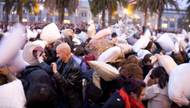More than 2,500 miles from Wall Street, the economic crisis can feel very far away in Las Vegas. The headlines are still dire, of course, the numbers still staggering, but the fall of a number of large financial institutions and the after shocks emanating from Manhattan seem very distant out here in the desert. We have tourism to protect us – our shining armor of industry against the economic meltdown.
But a quick instant message chat brought the situation into focus. “Last week was literally one of the worst of my life,” wrote a friend who works on Wall Street. He described the scene at Merrill Lynch, now Bank of America, where a frantic staff worked into the night calculating hundreds of millions of dollars of risk owed to Lehman Brothers that just disappeared when Lehman declared bankruptcy and was subsequently sold to Barclays Capital.
“It was a doomsday scenario,” he wrote.
Far from the frontlines of battle, it was hard to even picture the desperation gripping the country’s economic capital. Harder still was trying to understand what caused this dizzying nosedive. I reached out to professors Bernard Malamud and Thomas Carroll in UNLV’s economics department and asked them a simple question:
How did we get in this mess?
Edited for length and complexity, here is what they said:
It all started with the housing collapse.
Or rather, it all started with the real estate boom. In markets around the country housing prices shot up at unprecedented rates. Nevada was one of these places, and all over the valley new housing developments were sprouting out of the scrub. Credit was easy, and everyone, everyone was buying, some purchasing two or three houses or condominiums at a time with the intention of reselling them in a few months at a higher price. Many of these people, as well as those purchasing a single home with the intention of actually living in it, were signing adjustable rate mortgages – mortgages that start at a very low interest rate, but can shoot up to a much higher rate after only a few years.
“In order to feed the beast of increasing real estate prices you have to start offering loans to people who realistically cannot afford them.” Carroll explained. “It’s not that you’re giving loans to the poor, it’s that you’re giving loans to the middle class and upper middle classes for houses well beyond their ability to pay. A lot of these people who are in foreclosure are not poor people who will be tossed out of their homes. They are people who could’ve afforded the $300,000 home but decided they wanted the $750,000 home instead.”
When housing prices began to level off and eventually drop, many homeowners ended up “upside down” in their mortgage. “Their mortgage is greater than the value of their house on the resale market, and they figure foreclosure is the best option,” explained Malamud. The housing crisis had begun.
Foreclosures hit financial giants
With housing prices falling and foreclosures only speeding the plunge, the price of mortgage-backed securities – the bundles of thousands of mortgages that financial institutions trade amongst each other – also began to drop.
“Instead of waiting the 30 years for Joe Smith to pay his loan, you bundle it up and sell it off to the market. So, you don’t particularly care if he’s going to pay it or not, because you’re going to sell it,” Carroll said.
“Mortgages have been sliced and diced,” said Malamud. “Nobody is holding onto a single mortgage anymore. Mortgages have been thrown into a pool, split into different slices of securities – some that are very safe and some that are extremely risky … With prices of housing going down the underlying value of all that paper is going down. Who’s holding that paper? Since they’re pretty sophisticated, they’ve mostly been bought by financial institutions: Lehman Brothers, Bear Sterns. It was those investment banks that did the securitization, but they also held on to it, and that’s why they got into a lot of trouble.”
When home prices were high and foreclosures few, investing in mortgage-based assets was more than a safe bet, it was a smart decision. But the flood of foreclosures reversed the numbers. Gone were 30 years of interest payments and monthly deposits. Multiply that by thousands and you’ve got billions of dollars vanishing into the thin air of empty homes.
The crisis goes viral
The major financial institutions in the United States do a lot of business with each other, constantly loaning money back and forth, borrowing up and down Wall Street to pay for daily operating costs and high salaries for thousands of employees. Professor Malamud described the lending as “incestuous,” large advances that pass back and forth between the investment banks so regularly that a big enough blockage can throw them all off course.
“Major financial institutions are holding securities whose market value has clearly gone down. Nobody really wants to go near them, because it’s hard to judge what the value is. There isn’t really a market for them. So, you take an outfit like Lehman or Bear Sterns and they’ve bought a lot of this paper, and on the other side of their balance sheets they’ve issued their own IOUs … And if they can’t pay, the problem comes home to those other financial institutions, which then can’t pay their liabilities and everything seizes up,” Malamud said.
You end up with a credit freeze. Unable to recoup money they’ve lent out, banks stop lending. The entire credit system slows to a halt, and the firms left holding the devalued securities watch as their stock plummets.
This is exactly what’s happened in the last weeks with a number of financial groups that just a few months ago seemed rock solid. On Sept.15, Lehman Brothers financial-services firm filed for Chapter 11 bankruptcy. Founded in 1850, the firm’s filing marked the largest bankruptcy in U.S. history. On that same day, failing powerhouse Merrill Lynch was acquired for about $50 billion by Bank of America. The price worked out to $29 per share, down more than 80 percent from its high last year of $97.53.
“It’s a vicious circle,” said Malamud. “The headline, I suppose, is ‘Vicious Circle.’”
Stopping the plunge
With credit rapidly congealing and economic confidence breaking into splinters, the comparisons to 1929 and the Great Depression have been relentless. “That’s the bogeyman in the closet that everyone’s worried about,” Carroll said. “Had the Federal Reserve intervened in 1929 and kept banks from failing the Great Depression could have been avoided.”
Whether or not the same is true of today’s crisis remains to be seen. Already the federal government has come to the aid of a number of major financial institutions. In early September, the U.S. government assumed control of mortgage giants Fannie Mae and Freddie Mac, placing them on government conservatorship and taking over liabilities of more than $5 trillion of mortgages. Then on September 16, the Federal Reserve Bank made an $85 billion loan available to insurance heavyweight American International Group to combat the corporation’s liquidity crisis.
While that number may sound shocking, it’s overshadowed by the proposition put forward last week by Treasury Secretary Henry Paulson. His plan for stalling the crisis, drafted with the help of Federal Reserve Chairman Ben Bernanke, calls for a $700 billion bailout of the financial sector, that would have the government buying up nearly worthless mortgage-based assets from flailing private companies. The entire proposal was less than three pages long.
“Do we let the people who caused this disaster fail the way they should, but perhaps have a prolonged recession or do we say, ‘OK we’ll give them the $700 billion and that’ll show them never to cheat again?’ If you want to put an end to greed you may have to go through a fairly bad time here, but it may help us,” Carroll said.
While the plan has yet to gain Congress’ approval, many doubt that even so drastic a step will have the desired impact.
“The whole program is being summarized as ‘cash for trash,’” Malamud explained. “I came up with a term last summer when this started looking bad that was ‘Housing is too big to bail.’”
The massive bailout would raise the national debt to $11.3 trillion, and that in turn could have repercussions throughout the world economy.
“Who’s going to buy U.S. government bonds? That’s the ultimate safe haven, but foreigners in particular who’ve been buying our bonds may be a little reluctant because our government’s balance sheet is beginning to look like a third world proposition,” Malamud said.
For Nevadan homeowners still struggling to pay their mortgages and keep their homes, the bailout is more of a mirage. Practically none of the money is expected to trickle down to individual citizens.
“The $700 billion will do nothing to prevent foreclosures,” Carroll said. “The person who will be foreclosing on your property will no longer be AIG, it will be the U.S. Treasury, so now they own your mortgage, so pay up or get out. Obama put it best: ‘We have privatized profit but socialized loss.’”
And the crisis may soon reach beyond the rash of foreclosures spreading from Henderson to North Las Vegas. Perhaps it already has. With a credit crunch in effect, loans are nearly impossible to get, not only for private homebuyers, but also for small business owners and large casinos, too. Carroll predicts more breakdowns in casino expansions and sliding hotel occupancy rates as the recession steers American tourists away from luxuries like gambling.
However, There may be an upside for Las Vegas. If the dollar falls low enough, Vegas could enjoy a boom in foreign tourists.








Previous Discussion: